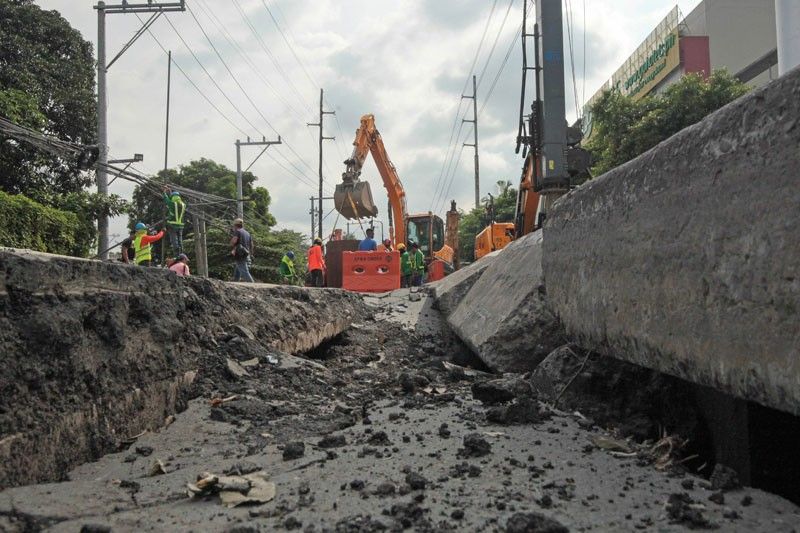Hundreds of simultaneous diggings to worsen traffic


Hundreds of simultaneous road diggings must be made starting next year to connect all Metro Manila homes and shops to sewage lines. Sewerage works will be rushed to comply with the Supreme Court’s shortened deadline to water authorities and the two concessionaires.
Expect traffic standstill as a thousand kilometers of city streets are torn up. Businesses would stall. Commuters will be unable to get to work, school, or anywhere. The P3.4 billion a day that experts say the economy loses to Manila traffic would multiply.
The diggings and drainpipe laying must be done at the same time within five years to 2024. The SC order was issued last week to the regulatory Metropolitan Waterworks and Sewerage Administration, and distributors Maynilad Inc. and Manila Water Co.
Rush jobs will tie up vehicles and pedestrians in the national capital’s 17 cities, and in Cavite and Rizal provinces that Maynilad and Manila Water serve. Even if only a city block long, sewerage work can take many months to complete. Metro Manila Development Authority and local government ordinances limit street diggings only from 10 p.m. to 4 a.m. on weekdays.
Siding with the Dept. of Environment and Natural Resources, the SC ruling aims to clean up Manila Bay. Earth NGOs are doubtful though. Studies rank the main polluters as: (1) piggeries, poultries, and factories in bayside Pampanga and Bulacan provinces, plus in inland Tarlac, Nueva Ecija, and Laguna whose rivers flow out to sea directly or via Lake Bai; (2) 250,000 squatter families who use esteros to Manila Bay as private toilets; and (3) homes and businesses with no sewer connections.
The SC also fined MWSS, Maynilad, and Manila Water P1 billion each, plus P322,000 per day of delayed payment. It was for failure to link new houses and buildings to sewage treatment plants (STPs) and sewers. Cited was the five years that the Clean Water Act of 2004 gave them to do so. But the three entities separately had invoked a 2011 SC ruling that overruled as unworkable the law’s five-year deadline so extended it to 2037.
The 2011 judgment had taken into account the failure since 2004 of other government entities to perform their roles under the Clean Water Act. For one, city halls should have provided the land, access roads, and licenses for the STPs. The Dept. of Public Works and Highways should have given a sewerage-septage master plan on which the MWSS could base its impositions on Maynilad and Manila Water. DENR field offices should have compelled new residential subdivisions, malls, high rises, and other constructions to install septic vaults and sewer links. The private distributors have no state power to coerce customers to connect, which is at subscribers’ cost, like cable-TV or Wifi. So the 2037 deadline depends on annual business plans, for which Maynilad has committed P400 billion and Manila Water P200 billion for STPs.
All that is now down the drain. The pressing issue is a looming social-economic disruption, five years of seemingly irremediable traffic gridlock.
* * *
For two years lawyer-historian Saul Hofileña Jr. and artist Guy Custodio regularly met to discuss Spain’s conquest of the archipelago. With time-worn photographs and manuscripts Hofileña gave animated narratives. Custodio egged him on with playful, if probing, questions. How could colonization and Christianization have been in flesh and blood, they imagined. The result: 39 collaborative paintings on that theme, as the indios must have experienced it.
In “Quadricula (HOCUS II)” Custodio interprets in oil on canvass and antique wood Hofileña’s “visions” of the past. Quadricula refers to the Spanish grid layout of municipios where they resettled the Christianized colonials. Around the square were the symbols of political, religious, and socio-economic authority: the ayuntamiento (town hall), iglesia, and elite mansiones. On each depiction of life and times around those, Hofileña and Custodio sign not their acronym but an icon. The Anghel de Cuyacuy is a winged indio in white tunic, reading a book while jiggling one leg and propping the other, a custom of Filipino males.
Curated by former tourism secretary Gemma Cruz Araneta, the exhibit runs till Mar. 15, 2020, Galleries 27/28 of the National Museum, which she once headed. Antique sculpture collections of Ho-Cus are also on show. Launched last weekend by National Museum director Jeremy Barnes, and board of trustees chairperson Luli Macapagal Arroyo Bernas.
* * *
Catch Sapol radio show, Saturdays, 8-10 a.m., DWIZ (882-AM).
Gotcha archives: www.philstar.com/columns/134276/gotcha
- Latest
- Trending




























